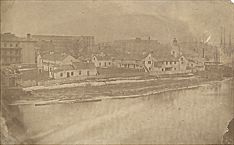| Entries |
| F |
|
Fort Dearborn
|

|
By 1808 the fort rose on a small hill of the south bank of the Chicago River, which wrapped along the Lake Michigan shoreline instead of emptying directly into the lake as it does today. The American soldiers and their families lived within the palisaded fort. To the south of the fort were the homes and businesses of the factor, interpreter, agent, merchant, and armorer. To the north of the river lived John Kinzie and other traders with British, French, and Indian ties.

|
A bronze marker in the pavement at Michigan Avenue and Wacker Drive marks the approximate site of the first and second Fort Dearborns.
Bibliography
Peterson, Jacqueline. “The Founding Fathers: The Absorption of French-Indian Chicago, 1816–1837.” In
Ethnic Chicago: A Multicultural Portrait,
4th ed., ed. Melvin G. Holli and Peter d'A. Jones, 1995.
Pierce, Bessie Louise.
A History of Chicago,
vol. 1. 1937.
Quaife, Milo M.
Checagou.
1933.
The Electronic Encyclopedia of Chicago © 2005 Chicago Historical Society.
The Encyclopedia of Chicago © 2004 The Newberry Library. All Rights Reserved. Portions are copyrighted by other institutions and individuals. Additional information on copyright and permissions.
The Encyclopedia of Chicago © 2004 The Newberry Library. All Rights Reserved. Portions are copyrighted by other institutions and individuals. Additional information on copyright and permissions.